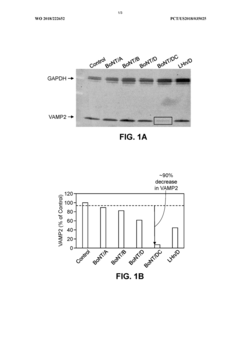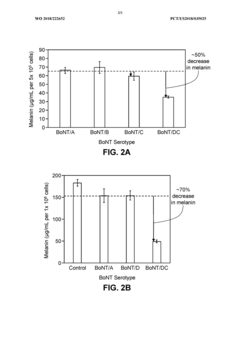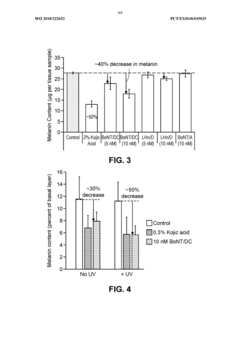Hypertonic in Dermatology: Understanding Emerging Techniques
Hypertonic Dermatology Evolution and Objectives
Hypertonic therapy in dermatology has evolved significantly over the past few decades, emerging as a promising approach for various skin conditions. The journey of hypertonic treatments in dermatology began with the recognition of osmotic effects on skin cells and tissues. Initially, hypertonic solutions were primarily used for wound cleansing and debridement, leveraging their ability to draw fluid from tissues and create an unfavorable environment for microbial growth.
As research progressed, the potential of hypertonic solutions in dermatology expanded beyond basic wound care. Scientists and clinicians began exploring their applications in managing inflammatory skin disorders, enhancing drug delivery through the skin barrier, and even in cosmetic dermatology for skin rejuvenation. This evolution was driven by a deeper understanding of skin physiology and the osmotic mechanisms at play when hypertonic solutions interact with skin tissues.
The objectives of current research and development in hypertonic dermatology are multifaceted. One primary goal is to optimize the composition and concentration of hypertonic solutions for specific dermatological conditions, ensuring maximum efficacy while minimizing potential side effects. Researchers are also focusing on developing novel delivery systems that can enhance the penetration and retention of hypertonic agents in the skin, thereby improving their therapeutic outcomes.
Another crucial objective is to elucidate the molecular mechanisms underlying the effects of hypertonic treatments on skin cells and the extracellular matrix. This knowledge is essential for tailoring treatments to specific pathological conditions and identifying new therapeutic targets. Additionally, there is a growing interest in combining hypertonic therapies with other treatment modalities, such as photodynamic therapy or topical medications, to achieve synergistic effects.
The field is also moving towards personalized approaches, recognizing that the efficacy of hypertonic treatments may vary based on individual skin characteristics and the specific nature of skin disorders. This has led to efforts in developing diagnostic tools and biomarkers that can predict treatment responses and guide therapy selection.
As the technology advances, there is an increasing focus on creating hypertonic formulations that not only provide therapeutic benefits but also improve patient comfort and compliance. This includes developing solutions with improved texture, reduced irritation potential, and enhanced cosmetic acceptability. The ultimate aim is to establish hypertonic therapy as a versatile, effective, and well-tolerated treatment option across a wide spectrum of dermatological conditions, from chronic inflammatory disorders to aesthetic concerns.
Market Analysis for Hypertonic Dermatological Solutions
The global market for hypertonic dermatological solutions is experiencing significant growth, driven by increasing skin disorders, rising awareness of skincare, and advancements in dermatological treatments. This market segment is expected to expand at a robust rate over the next five years, with a particular focus on innovative hypertonic formulations for various skin conditions.
Hypertonic solutions in dermatology are gaining traction due to their effectiveness in treating conditions such as eczema, psoriasis, and acne. These solutions work by drawing out excess fluid from the skin, reducing inflammation, and promoting healing. The market is seeing a shift towards natural and organic ingredients in hypertonic formulations, catering to the growing consumer demand for clean beauty products.
The Asia-Pacific region is emerging as a key market for hypertonic dermatological solutions, fueled by a large population base, increasing disposable income, and growing awareness of skin health. North America and Europe continue to be significant markets, with a strong emphasis on research and development of advanced hypertonic treatments.
Key players in the market include established pharmaceutical companies and emerging biotech firms specializing in dermatological innovations. These companies are investing heavily in research and development to create more effective and targeted hypertonic solutions. Collaborations between academic institutions and industry players are also driving innovation in this field.
The market is witnessing a trend towards personalized skincare solutions, with companies developing hypertonic products tailored to specific skin types and conditions. This customization is expected to be a major driver of market growth in the coming years. Additionally, the integration of technology in skincare, such as smart devices for skin analysis and product recommendation, is creating new opportunities for hypertonic dermatological solutions.
Regulatory approvals and clinical trials play a crucial role in shaping the market landscape. Companies are focusing on obtaining necessary certifications and conducting extensive studies to validate the efficacy and safety of their hypertonic products. This emphasis on scientific validation is expected to boost consumer confidence and drive market growth.
The COVID-19 pandemic has had a mixed impact on the market. While it initially disrupted supply chains and reduced in-person dermatology consultations, it has also led to increased focus on personal skincare and hygiene, potentially benefiting the hypertonic dermatological solutions market in the long term.
Current Hypertonic Techniques and Challenges
Hypertonic techniques in dermatology have gained significant attention in recent years due to their potential for addressing various skin conditions. Currently, several approaches are being explored and implemented, each with its own set of challenges and limitations.
One of the primary hypertonic techniques in dermatology is the use of hypertonic saline solutions for wound cleansing and management. This method leverages the osmotic gradient created by the high salt concentration to draw fluid from the wound, reducing edema and promoting healing. However, challenges arise in determining the optimal concentration and application frequency to maximize efficacy while minimizing potential tissue damage.
Another emerging technique involves hypertonic glucose solutions for treating certain skin infections. These solutions create an unfavorable environment for bacterial growth while simultaneously promoting wound healing. The main challenge lies in developing formulations that maintain their hypertonic properties over extended periods without causing irritation or adverse reactions in surrounding healthy tissue.
Hypertonic hydrogels represent a promising avenue in dermatological applications. These advanced materials can absorb excess wound exudate while maintaining a moist wound environment conducive to healing. However, formulating hydrogels with consistent hypertonic properties and ensuring their stability during storage and application remains a significant technical hurdle.
The use of hypertonic microneedle patches is an innovative approach gaining traction in transdermal drug delivery for dermatological conditions. These patches create temporary microchannels in the skin, allowing for enhanced penetration of hypertonic drug formulations. The challenge lies in optimizing the microneedle design and hypertonic drug formulation to achieve consistent and controlled delivery across various skin types and conditions.
Hypertonic cryotherapy is another technique being explored for treating certain skin lesions and tumors. This method involves applying extremely cold, hypertonic solutions to targeted areas, inducing cellular damage through both freezing and osmotic stress. The primary challenge is achieving precise control over the treatment area and depth to minimize damage to surrounding healthy tissue.
Despite the promising advancements, several overarching challenges persist in the field of hypertonic techniques in dermatology. One major issue is the lack of standardized protocols for many of these emerging treatments, making it difficult to compare efficacy across studies and clinical settings. Additionally, the long-term effects of repeated exposure to hypertonic treatments on skin health and barrier function remain poorly understood, necessitating further research.
Another significant challenge is the development of personalized hypertonic treatments that can be tailored to individual patient needs and skin characteristics. This requires a deeper understanding of how factors such as age, skin type, and underlying health conditions influence the response to hypertonic therapies.
Existing Hypertonic Dermatological Approaches
01 Hypertonic solutions for skin hydration
Hypertonic solutions are used to enhance skin hydration by drawing water to the skin surface through osmosis. These solutions typically contain high concentrations of solutes such as salts or sugars, which create an osmotic gradient that pulls water from deeper skin layers to the surface, improving hydration and potentially reducing transepidermal water loss.- Hypertonic solutions for skin hydration: Hypertonic solutions can be used to enhance skin hydration by creating an osmotic gradient that draws water to the skin surface. This technique can improve skin moisture content and potentially reduce the appearance of fine lines and wrinkles. The method may involve topical application or transdermal delivery systems.
- Devices for hypertonic skin treatment: Specialized devices have been developed to apply hypertonic solutions or create hypertonic conditions on the skin. These devices may use various mechanisms such as iontophoresis, ultrasound, or microneedles to enhance the penetration and effectiveness of hypertonic treatments for skin hydration.
- Composition of hypertonic formulations: Hypertonic formulations for skin hydration often include specific ingredients such as high concentrations of salts, sugars, or other osmotically active compounds. These compositions are designed to maximize the osmotic effect while maintaining skin compatibility and may also incorporate additional beneficial ingredients for skin health.
- Monitoring and assessment of skin hydration: Methods and devices for monitoring skin hydration levels and assessing the effectiveness of hypertonic treatments have been developed. These may include sensors, imaging techniques, or biomarkers to measure skin moisture content, barrier function, and overall hydration status before and after hypertonic interventions.
- Combination therapies with hypertonic techniques: Hypertonic techniques for skin hydration can be combined with other therapeutic approaches to enhance overall skin health and appearance. This may include integration with anti-aging treatments, wound healing protocols, or management of specific skin conditions, leveraging the synergistic effects of multiple modalities.
02 Transdermal delivery systems for hydration
Advanced transdermal delivery systems are employed to enhance skin hydration by facilitating the penetration of hydrating agents into deeper skin layers. These systems may use various technologies such as nanocarriers, liposomes, or iontophoresis to improve the absorption and efficacy of moisturizing compounds.Expand Specific Solutions03 Bioelectric stimulation for skin hydration
Bioelectric stimulation techniques are utilized to enhance skin hydration by promoting the natural moisturizing processes of the skin. These methods may involve the use of microcurrents or other forms of electrical stimulation to increase cellular activity, improve circulation, and enhance the skin's ability to retain moisture.Expand Specific Solutions04 Hyaluronic acid-based hydration techniques
Hyaluronic acid, a powerful humectant, is incorporated into various formulations and delivery systems to enhance skin hydration. Advanced techniques may involve cross-linked hyaluronic acid or combination with other hydrating agents to provide long-lasting moisture retention and improve overall skin hydration levels.Expand Specific Solutions05 Hydration measurement and monitoring devices
Innovative devices and methods are developed to accurately measure and monitor skin hydration levels. These technologies may use various principles such as electrical impedance, spectroscopy, or imaging techniques to provide real-time data on skin moisture content, allowing for more targeted and effective hydration treatments.Expand Specific Solutions
Key Players in Hypertonic Dermatology Field
The field of hypertonic techniques in dermatology is experiencing rapid growth, with the market currently in an expansionary phase. The global dermatology devices market, which includes hypertonic technologies, is projected to reach significant size in the coming years. Technological maturity varies across different applications, with some techniques more established than others. Companies like Allergan, Inc., Galderma Research & Development SNC, and Revance Therapeutics, Inc. are at the forefront of innovation, developing advanced hypertonic solutions for various skin conditions. Emerging players such as Neodyne Biosciences, Inc. and Cytrellis Biosystems, Inc. are also making strides in this space, focusing on novel approaches to dermal remodeling and skin tightening using hypertonic technologies.
Allergan, Inc.
Neodyne Biosciences, Inc.
Innovative Hypertonic Dermatology Research
- Administration of a botulinum neurotoxin mosaic, specifically BoNT/DC, which cleaves VAMP-2, reducing melanin content and hyperpigmentation by inhibiting melanocyte activity, administered via injection or topically to treat conditions like melasma and solar lentigo.
- The development of methods and compositions that identify and utilize agents modifying the function of the pink-eyed dilution protein (P protein), including agonists, antagonists, and mimetics, to enhance or inhibit melanin production, thereby treating melanoma and pigmentation disorders by assessing cell viability and glutathione levels.
Safety and Efficacy Considerations
The safety and efficacy of hypertonic solutions in dermatology are paramount considerations as these techniques gain traction in clinical practice. Hypertonic solutions, characterized by their higher solute concentration compared to bodily fluids, have shown promising results in various dermatological applications. However, their use necessitates careful evaluation of both short-term and long-term effects on skin health and overall patient well-being.
Safety considerations primarily revolve around the potential for skin irritation, dehydration, and disruption of the skin barrier function. The high osmolarity of hypertonic solutions can lead to temporary discomfort, redness, and a stinging sensation upon application. In some cases, prolonged or excessive use may result in dryness, flaking, or even micro-tears in the skin surface. These effects are generally transient but require careful monitoring and patient education to ensure proper use and minimize adverse reactions.
Efficacy assessments of hypertonic solutions in dermatology have yielded encouraging results across various conditions. In wound healing, hypertonic dressings have demonstrated enhanced debridement capabilities, effectively removing necrotic tissue and promoting a clean wound bed. For inflammatory skin conditions such as eczema and psoriasis, hypertonic treatments have shown potential in reducing inflammation, itching, and scaling, although more extensive clinical trials are needed to establish long-term benefits.
The mechanism of action for hypertonic solutions in dermatology is primarily attributed to their osmotic effects. By creating an osmotic gradient, these solutions can draw out excess fluid from inflamed or edematous tissues, potentially reducing swelling and promoting healing. Additionally, the high salt concentration may have antimicrobial properties, contributing to infection control in wound management.
However, the efficacy of hypertonic treatments can vary depending on factors such as solution concentration, application method, and individual patient characteristics. Standardization of protocols and dosing regimens remains a challenge, highlighting the need for more comprehensive clinical studies to optimize treatment parameters across different dermatological indications.
Long-term safety data on the repeated use of hypertonic solutions in dermatology is still limited. Concerns include the potential for cumulative effects on skin barrier function, alterations in skin microbiome, and possible systemic absorption of high salt concentrations. Ongoing research is focused on addressing these knowledge gaps and developing strategies to mitigate any long-term risks while maximizing therapeutic benefits.
As hypertonic techniques continue to evolve, the integration of advanced delivery systems and combination therapies presents opportunities to enhance both safety and efficacy. Nanoparticle-based formulations and controlled-release mechanisms are being explored to improve targeted delivery and minimize side effects. Furthermore, combining hypertonic solutions with other established dermatological treatments may yield synergistic benefits, potentially expanding their therapeutic applications.
Patient-Centric Hypertonic Treatment Design
Patient-centric hypertonic treatment design in dermatology represents a significant shift towards personalized and effective skincare solutions. This approach focuses on tailoring hypertonic treatments to individual patient needs, considering factors such as skin type, condition severity, and patient lifestyle.
One key aspect of patient-centric design is the development of customizable hypertonic formulations. These allow dermatologists to adjust the concentration of osmotic agents, such as glycerin or sodium chloride, based on the specific requirements of each patient. This flexibility ensures optimal efficacy while minimizing potential side effects.
Another important consideration is the delivery method of hypertonic treatments. Patient-centric designs incorporate various application techniques, including creams, gels, and specialized patches. These options cater to different preferences and lifestyles, improving treatment adherence and overall patient satisfaction.
The integration of smart technology in hypertonic treatments is an emerging trend in patient-centric design. Wearable devices and mobile applications can monitor skin hydration levels and provide real-time feedback, allowing patients to adjust their treatment regimens accordingly. This data-driven approach enhances treatment efficacy and empowers patients to take an active role in their skincare.
Patient comfort is a crucial factor in hypertonic treatment design. Innovative formulations aim to reduce common side effects such as stinging or burning sensations, making treatments more tolerable for long-term use. Additionally, the development of time-release technologies ensures a sustained hypertonic effect while minimizing the frequency of applications.
Considering the diverse needs of patients, multi-functional hypertonic treatments are gaining popularity. These products combine osmotic agents with other active ingredients, such as antioxidants or anti-inflammatory compounds, to address multiple skin concerns simultaneously. This holistic approach not only simplifies skincare routines but also provides comprehensive dermatological care.
Patient education is an integral part of patient-centric hypertonic treatment design. Clear instructions, visual aids, and interactive tools help patients understand the proper application techniques and expected outcomes. This knowledge empowers patients to make informed decisions about their treatment and improves overall compliance.
In conclusion, patient-centric hypertonic treatment design in dermatology focuses on creating personalized, effective, and user-friendly solutions. By considering individual patient needs, incorporating advanced technologies, and prioritizing patient comfort and education, these innovative approaches are revolutionizing the field of dermatological care.


